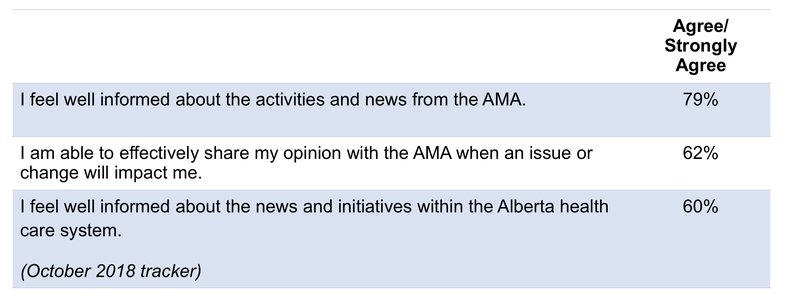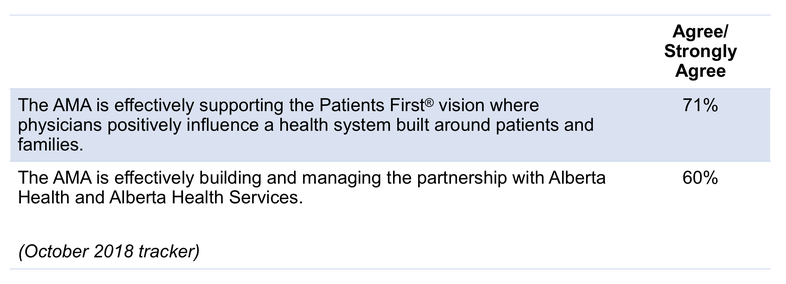For the past 20 years, TWI Surveys has partnered with the Alberta Medical Association to research members’ needs and understand their priorities. Much of the research involves results of three to six surveys per year. In 2018, we conducted two tracking surveys to assess member opinion on strategic indicators and unique issues. A third survey addressed members’ insurance needs and experiences. This article contains our thoughts about how the AMA is communicating and engaging with members.
More engagement. More agreement.
Based on qualitative comments in 770 member responses, over two tracking surveys, we know that members were more engaged than in the past, and those in family medicine and specialist fields were more aligned in their views.
In October 2018, AMA members continued to indicate quantitatively that they were more engaged, given significant gains in agreement compared to survey results in 2017. The progress made in spring 2018 had been sustained through the fall of that year. Positive momentum was buoyed by significant increases in agreement among the specialists.

Members feel well informed, but more work needed
The surveys indicated that AMA’s efforts in outreach, collaboration and communication had met with increased levels of agreement. The tracking survey aligned with AMA’s strategic intent and critical initiatives taken on behalf of members and patients. When members agree with the tracking statements, it is considered a positive indicator of engagement and support for the association’s efforts.

Advocacy
While the trend in recent survey results is positive, comments shared by respondents in October 2018 demonstrated that the work of engagement is far from done: members want to see quality as a focus and want inequities addressed.
As the focus of recent surveys has shifted to AMA’s current initiatives, it appears that other groups or topics have less significance in the eyes of members. For instance, when the compensation process is updated, some members feel Patients First® becomes secondary, or when relationships with Alberta Health Services are improved, member advocacy seems to diminish.

Primary Care Network evolution
Members tend to receive communications about AMA initiatives in short and focused parts to avoid information overload. As a result, they may not be aware of other relevant information that is underway. This challenge is common for all organizational and leadership communications.
The complexity of the Alberta health care system and the high number of sub-groups makes it all the more difficult for members to see how parts of a strategy connect. The AMA needs to work with members to move the conversation back to shared vision and principles and focus on the phase of the process underway. Through this collaborative effort, the very specific information relevant at the moment can emerge.
Two member comments from the October Tracker highlighted how physicians can see the same situation in a very different light, creating another communication and leadership challenge. One physician responded positively to the value and impact of PCNs, while another physician highlighted the cost of administration and what is perceived as added complexity. In situations like this, members should trust that the AMA understands their needs and those of their practices and will effectively advocate for them.

Sense of belonging to the AMA
The AMA should continue to use surveys and other communication opportunities to mirror back to members what they have said, how they feel, how they connect to each other and how they are different. Supporting and maintaining a general awareness of members, for members, helps them see how they fit in.
A member’s sense of belonging to the AMA is as necessary to engagement as professional autonomy and clarity of purpose. All three needs must be met for the AMA to successfully navigate the demands placed on physicians in the Alberta health care system while enabling their wellbeing and leadership. In 2018, members were more aligned and engaged than in previous years. In 2019, more effort will be needed to maintain or grow that engagement.
Highlights from the issues in the April 2018 tracker
Thinking about your own practice and patients, and considering the broad categories below, what are the two biggest issues affecting you? (top five selections)
- Work and life balance
- Lack of resources
- Career stage issues (retirement, etc.)
- Wait times
- Changing patient demands
More highlights from the issues in the October 2018 tracker
- 50% of members are aware that the AMA sponsors the Youth Run Club.
- Those with few years in practice were more likely to want to volunteer with the Youth Run Club.
- 39% of members read Optimized Prescribing with Seniors (OPS).
- Of those who read OPS, 99% found it helpful at least sometimes.
- 9% of members report to prescribing medical cannabis.
Distribution and data responses
AMA conducted its first tracking survey of 2018 with a random sample of 3,000 members. The survey opened on April 12, 2018 and closed on April 24, 2018. Responses were received from 397 members for a response rate of 13%. The data is valid 19 times out of 20 within a margin of error of +/- 4.85%.
AMA conducted its second tracking survey of 2018 with a random sample of 3,000 members. The survey opened on October 24, 2018 and closed on November 2, 2018. Responses were received from 373 members for a response rate of 12%. The data is valid 19 times out of 20 within a margin of error of +/- 5.01%.
Banner photo credit: Andi Breit, pixabay.com
